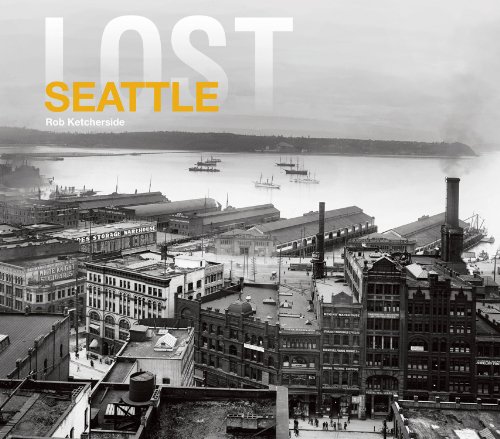List of the Top 7 seattle architecture you can buy in 2019
When you want to find seattle architecture, you may need to consider between many choices. Finding the best seattle architecture is not an easy task. In this post, we create a very short list about top 7 the best seattle architecture for you. You can check detail product features, product specifications and also our voting for each product. Let’s start with following top 7 seattle architecture:
Best seattle architecture
1. Shaping Seattle Architecture: A Historical Guide to the Architects, Second Edition (Samuel and Althea Stroum Book, Jackson School Publications i)
Description
The first edition of Shaping Seattle Architecture, published in 1994, introduced readers to Seattles architects by showcasing the work of those who were instrumental in creating the regions built environment. Twenty years later, the second edition updates and expands the original with new information and illustrations that provide an even richer exploration of Seattle architecture.The book begins with a revised introduction that brings the story of Seattle architecture into the twenty-first century and situates developments in Seattle building design within local and global contexts. The books fifty-four essays present richly illustrated profiles that describe the architects' careers, provide an overview of their major works, and explore their significance.
Shaping Seattle Architecture celebrates a wide range of people who helped form the region's built environment. It book provides updated information about many of the architects and firms profiled in the first edition. Four individuals newly included in this second edition are Edwin J. Ivey, a leading residential designer; Fred Bassetti, an important contributor to Northwest regional modernism; L. Jane Hastings, one of the regions foremost women in architecture; and Richard Haag, founder of the landscape architecture program at the University of Washington and designer of Gas Works Park and the Bloedel Reserve.
The book also includes essays on the buildings of the Coast Salish people, who inhabited Puget Sound prior to Euro-American settlement; the role that architects played in speculative housing developments before and after World War II; and the vernacular architecture built by nonprofessionals that makes up a portion of the fabric of the city.
Shaping Seattle Architecture concludes with a substantial reference section, updated to reflect the last twenty years of research and publications. A locations appendix offers a geographic guide to surviving works. The research section directs interested readers to further resources, and the appendix Additional Significant Seattle Architects provides thumbnail sketches of nearly 250 important figures not included in the main text.
2. Seattle Architecture: A Walking Guide to Downtown
Feature
Used Book in Good ConditionDescription
Winner of Historic Seattle's Preservation Education and Publications AwardSeattle Architecture: A Walking Guide to Downtown opens with an historical overview and timeline featuring the people and events that have shaped the Seattle that we know today. The guidebook is divided into nine tours beginning where Seattle did, at Pioneer Square, and ending at Seattle Center, the location of the futuristic-themed 1962 Century 21 World's Fair. The front flap folds out, providing a map of the areas covered in the book.
Each tour is accompanied by an introduction and area map with points of interest identified by numbers that correspond to individual entries. Architect names and dates of completion are provided at the beginning of each entry, and an icon indicates when a building is on a local or national landmarks register.
3. Lost Seattle
Feature
Pavilion BooksDescription
Unearths the buried bones of an invented city that was carved out of hills and bay.Early Seattleites were neither sentimental nor nostalgic, destroying iconic schools, libraries, entire neighborhoods, and high hills.They ripped out the very muscles of industry and the veins of rails and ferries on which the city was created.
68 vignettes of cast-aside Seattle are given new light, including Japantown, the Kalakala, Joseph Mayer's clock factory, interurban railways, Yesler's mill, Capitol Hill's auto row, Denny Hill, Moran Brothers' shipyard, the Carnegie Central Library, Boeing and the SuperSonics. From the 1880s to the present day.
This richly illustrated book brings these lost buildings, structures and neighborhoods back to life, to reveal the Seattle that once was.
4. Shaping Seattle Architecture: A Historical Guide to the Architects
Description
Seattle's growth has been remarkable; from a population of only 3,500 in 1880 the city grew to over 500,000 in 1990, and the Puget Sound region exploded to a population of nearly three million. Shaping Seattle Architecture: A Historical Guide to the Architects focuses on those whose designs shaped the physical form of the city and region. Forty-five generously illustrated profiles of architects and firms provide an overview of Seattle's architectural history as well as a handy reference guide to the life and work of these designers.Jeffrey Ochsner's introductory chapter summarizes the main currents of Seattle's architectural history, relating it both to the city's history and to national and international trends in architecture. Three special essays, focusing on the region's Native American architecture; on the impact of pattern books, plan books, and periodicals; and on "vernacular" and "popular" architecture - ordinary structures often built without the participation of professional designers - are valuable additions to the book. Only architects no longer actively practicing are included in the individual profiles, but an appendix providing over eighty thumbnail sketches of additional significant Seattle architects and the works for which they are most noted does include recent AIA-Seattle Medal winners. Non-Seattle architects who designed major Seattle structures are listed separately. Another appendix lists the extant buildings mentioned in the text, along with their current names and addresses, including buildings across the Northwest and elsewhere. Sections on sources of information and on researching Seattle architecture provide suggestions for finding out more about a particular architect, building, or project.
5. Seattleness: A Cultural Atlas
Description
This visually rich cultural atlas of Seattle explores the mercurial nature of place through the lens of one of the fastest growing cities in America. Through both experiential and data-driven cartography, Seattleness lends itself to longtime residents, newcomers to the city, and those curious about the moody borough that has brought us airplanes, grunge, gourmet coffee, and e-commerce.In the style of Infinite City and Portlandness, this illustrated book examines an expansive range of topics from UFO sightings to pinball legacies, gray skies to frontier psychology, strong women and strong coffee. Compelling infographic visuals emerge from deep dives into data, unraveling over 50 real and strange narratives about the green metropolis perched at the edge of the Salish Sea.
6. Historic Seattle Architecture: The Aesthetic Alchemy of Ambiance and Chaos (Vertical Washington) (Volume 5)
Description
Historic Seattle Architecture is author and photographer Marques Vickers illustrated edition of the citys most prominent high-rise constructions built between 1890-1930. Over 250 photographs document over 125 historical structures establishing a visual profile and economic time capsule of Seattles early economic legacy. The edition portrays some of the most influential downtown constructions including the Smith and Seattle Towers, Washington Mutual Triangle, Coliseum Theatre and the Interurban, Arctic, Dexter Horton, and Pioneer Buildings. Photographs from multiple perspectives accentuate distinctive architectural traits and detailing. Contemporary Seattle is undergoing a dynamic resurgence of architectural construction consisting primarily of skyscrapers. Each completed monolith provides an intriguing and often imposing contrast to the modestly scaled structures from a distant era. With the passage of time, historical constructions and their unique aesthetics remain statuesque and relevant. Historical preservationist groups have fought successfully for their survival. This appreciation has enabled Seattle to assume a distinctive and prominent position as a leader in West Coast architecture. Seattles integration of traditional and contemporary design reinforces its image as a desire urban living environment. Few American cities can still document the precise stages of their evolution by the remaining strata of their architecture. Seattle is an exemplary example showcasing that capability. Historically Seattle was deeply traumatized financially by the slowdown caused by the nationwide Panic of 1893. Misfortune was compounded by calamity with a devastating June 6th, 1889 fire that decimated 25 downtown blocks. The entire layout of wood framed structures was destroyed. The catastrophe ironically rejuvenated the downtown, resulting in a fervent reconstruction program consisting exclusively of stone and brick structures. Wood framed buildings were prohibited. The Klondike gold rush of 1896 spurred regional economic activity, particularly in providing goods and services to the Alaskan bound miners. During the first two decades of the 20th century, Seattle accommodated a massive incoming immigration. The influx resulted in the creation of outlying tightly concentrated neighborhoods. The downtown core swelled minus coordinated zoned planning. Steep hillsides were lowered to enable fresh constructions and greenbelt territories. Parklands, bridges and public works projects proliferated creating a diverse blend of ambiance and chaos. In 1914, the 38-story Smith Tower was constructed and named after firearm and typewriter magnate Lyman Cornelius Smith. He would not live to see its completion. The skyscraper was Seattles first and among the tallest outside of New York City at the time of its completion. It remained the tallest building west of the Mississippi until 1931 and was only eclipsed within Seattle upon the construction of the iconic Space Needle in 1962. Historic Seattle Architecture showcases the unique charm of a Seattle that was and still remains. It is Marques Vickers fifth photo compilation of Seattle and Bellevue architecture and provides an important transitional resource to portray the continuity of regional development.7. Office for Metropolitan Architecture: Seattle Public Library










Recent Comments